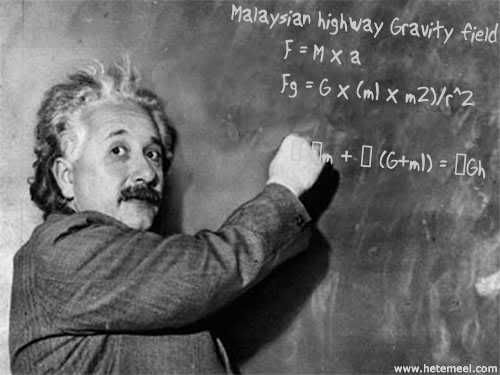The Malaysian Highway Gravity Field Theory
Technorati tags: Humor, Observations, Highway, Malaysiana, Road Etiquette
Ever notice, when you're driving on the highway, that vehicles tend to meander to the fast lane - the one that's closest to the highway divider? And usually regardless of how fast (or not) that vehicle happens to travel?
Walski does a lot of driving. To work. From work. From work to customer's premises. Shopping.. the list of destinations is endless.
One day it dawned upon Walski that there must be some mysterious force at work, causing vehicles to get attracted to the fast lane, regardless of how slow or fast they're going, or how much of a fucking nuisance they're being to other road users.
So, Walski sat down and started to do a bit of calculating.
 Einstein was not exhumed for this exercise
Einstein was not exhumed for this exercise
After several hours of calculating, correlating and assimilating visual data, road distance vs average vehicular mass, automobile aerodynamics vs truck-to-tire ratios, and numerous other nitpicky parameters, Walski came to this startling conclusion:
What we always thought was just a highway divider is actually a gravity belt that runs the length of a given stretch of highway!
 The Malaysian Highway Gravity Belt and its Field Effect
The Malaysian Highway Gravity Belt and its Field Effect
Walski calls this the Malaysian Highway Gravity Belt. The actual equation is complex and too mind numbing for the average human to fathom (even smart Pandas find it mind-boggling). But derived from this complex equation are the following Gravity Belt Laws:
Law #1: A vehicle on a relatively empty highway will naturally be attracted to where the pull is greatest - i.e. towards the highway median (on the fast lane) - the faster the vehicle the stronger the gravitational pull.
Law #2: On a congested stretch of highway, the gravitational pull will saturate when the fast lane comes to a standstill, causing a slingshot effect, allowing the slow lane to move faster. In extreme cases, the slingshot effect extends to the emergency lane, where vehicles tend to move at a faster velocity, inversely proportional to their mass. (more laws and their effects in the full post)
Law #3: Gravitational effects on heavy vehicles (especially very laden ones) are greater when the highway gradient is >3.5567%. The added mass on the fast lane thus increases the gravitational pull, sucking in more vehicles, until saturation is achieved (see Law #2).
Law #4: The presence of moisture (usually from rain) causes a strengthening of the gravitational field, thus allowing saturation to occur faster. Through the application of the principals of particle physics, vehicles will tend to create virtual lanes in order to maintain their forward velocity, often leading to greater traffic saturation.
And finally,
Law #5: The positioning of traffic barriers (those ugly orange and white thingys) along the highway divider/Gravity Belt causes the radius of the Gravity Belt to extend to the periphery of where the barriers are located. This phenomenon has been observed with both concrete and plastic barriers.
These laws are currently being studied, and confirmed with additional field data, by Walski's crack research team, comprising one battalion of the highest IQ C.R.A.P. (Cybernetic Remote Autonomous Pararoaches), distributed across all the major highways nationwide, at strategic locations (so if you happen to see one, please do not run it over).
So, the next time you drive on the highway, observe the traffic behavior and see if Walski's theory is right, or not. But while on the highway, don't be part of the gravitational problem yourself!
















